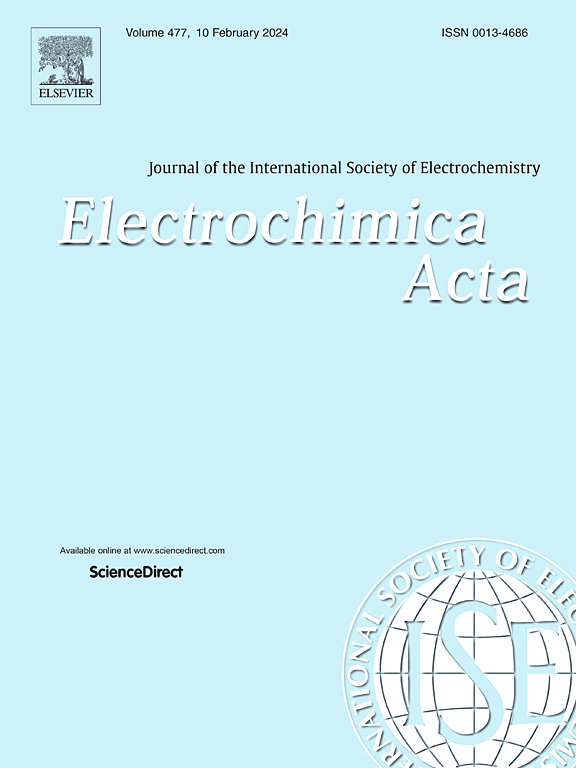Electrochemical biosensor based on ultrathin 2D CN-rGO@AgNPs for ROS detection in leukemia cells
IF 5.6
3区 材料科学
Q1 ELECTROCHEMISTRY
引用次数: 0
Abstract
Accurate monitoring of ROS levels is essential for oxidative stress (OS) management, but their low concentration and instability pose significant detection challenges. Here, we developed a highly sensitive and selective electrochemical biosensor for real-time, micro-volume ROS detection in leukemia cells.
The sensor was fabricated using ultrathin g-C₃N₄-rGO (CN-rGO) nanosheet synthesized through a calcination and hydrothermal approach. These nanosheets were deposited onto a screen-printed carbon electrode (SPE) and further modified with silver nanoparticles (AgNPs) to construct a CN-rGO@AgNPs/SPE biosensor. The porous nanostructure significantly enhanced the catalytic surface area and electron transfer efficiency, achieving high sensitivities towards H₂O₂ and O₂·⁻ detection. Using a window titration platform, the sensor detected ROS in 0.1 mL lysates of leukemia cell lines (U-937, THP-1, and MOLM-13) with concentrations of 7.38 ± 4.81 μM, 11.74 ± 0.985 μM, 19.84 ± 3.73 μM, respectively. Furthermore, the platform allowed precise monitoring of doxorubicin (DOX)-induced OS, providing valuable insights for guiding leukemia chemotherapy. Additionally, Lipopolysaccharide (LPS) stimulation experiments demonstrated the sensor's exceptional real-time performance, enabling dynamic detection of H₂O₂ release kinetics and ROS generation rates at the cellular level.
Combining high sensitivity, low detection limits, and micro-volume analysis capabilities, this sensor holds great potential for clinical auxiliary diagnosis and drug efficacy assessment in leukemia research.
基于超薄2D电化学生物传感器CN-rGO@AgNPs的白血病细胞ROS检测
准确监测ROS水平对氧化应激(OS)管理至关重要,但其低浓度和不稳定性给检测带来了重大挑战。在这里,我们开发了一种高灵敏度和选择性的电化学生物传感器,用于实时、微体积检测白血病细胞中的ROS。该传感器采用煅烧-水热法制备超薄g-C₃N₄-rGO (CN-rGO)纳米片。将这些纳米片沉积在丝网印刷碳电极(SPE)上,并用银纳米颗粒(AgNPs)进一步修饰,构建CN-rGO@AgNPs/SPE生物传感器。多孔纳米结构显著提高了催化表面积和电子传递效率,对H₂O₂和O₂·毒枭检测具有很高的灵敏度。利用窗口滴定平台检测白血病细胞系(U-937、THP-1和MOLM-13) 0.1 mL裂解液中ROS的浓度,分别为7.38±4.81 μM、11.74±0.985 μM和19.84±3.73 μM。此外,该平台可以精确监测阿霉素(DOX)诱导的OS,为指导白血病化疗提供有价值的见解。此外,脂多糖(LPS)刺激实验证明了传感器卓越的实时性能,能够在细胞水平上动态检测H₂O₂释放动力学和ROS生成率。该传感器具有高灵敏度、低检出限和微体积分析能力,在白血病研究的临床辅助诊断和药物疗效评价方面具有很大的潜力。
本文章由计算机程序翻译,如有差异,请以英文原文为准。
求助全文
约1分钟内获得全文
求助全文
来源期刊

Electrochimica Acta
工程技术-电化学
CiteScore
11.30
自引率
6.10%
发文量
1634
审稿时长
41 days
期刊介绍:
Electrochimica Acta is an international journal. It is intended for the publication of both original work and reviews in the field of electrochemistry. Electrochemistry should be interpreted to mean any of the research fields covered by the Divisions of the International Society of Electrochemistry listed below, as well as emerging scientific domains covered by ISE New Topics Committee.
 求助内容:
求助内容: 应助结果提醒方式:
应助结果提醒方式:


